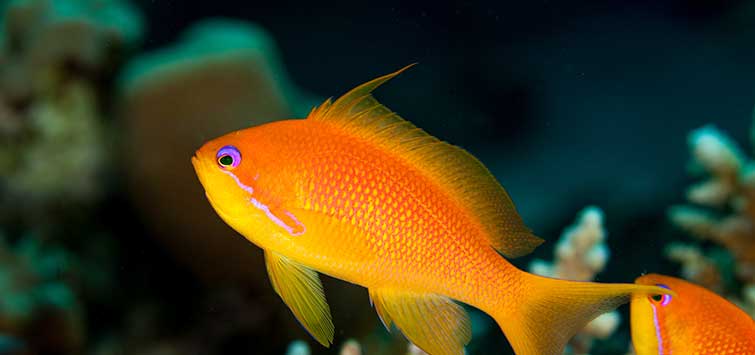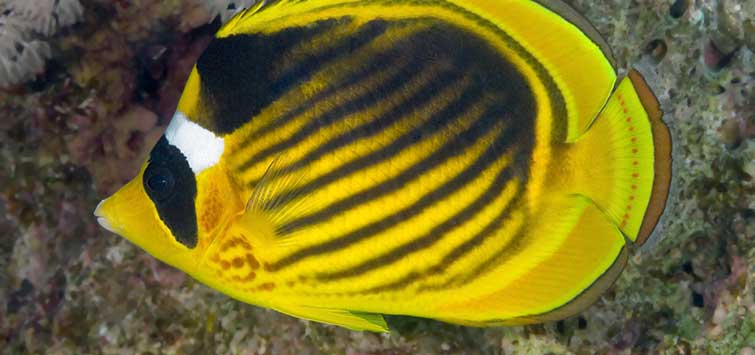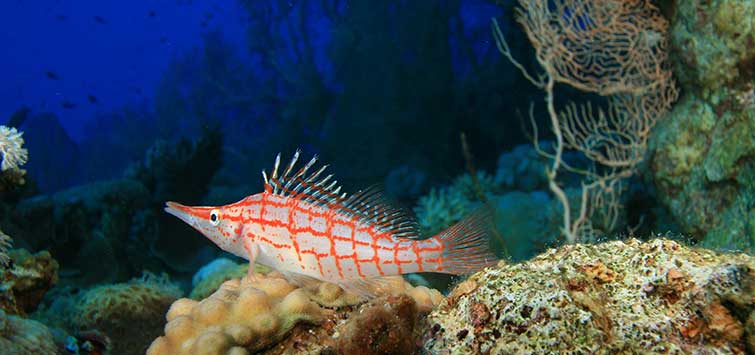An Underwater Photographer's 6 Favorite Reef Species
Author: Richard Aspinall
Photography is an expensive business at the best of times, and more so if you want to use quality equipment. Taking your gear underwater then multiplies the cost of the original purchase. When you also include diving gear and travel expenses, it becomes a rather pricy pastime. I think my bank account would prefer I found a cheaper way to spend my time. (If only there were a way to see these habitats replicated in your own home.)
For now, photographing the underwater world has largely replaced my fishkeeping hobby, and I’ve decided to concentrate on exploring wild reefs rather than keeping a captive one. I can’t afford everything, after all.
Have Swim Fins, Will Travel
I’ve always loved scuba diving and studying reefs around the world. Diving has been a great way to further my understanding of them and other marine habitats. It’s also a wonderful way to gain inspiration for aquascaping and to learn more about the lives of many species that are popular in the aquarium trade. On occasion, it’s even reinforced my opinion that some are simply unsuited to captivity and should be left in the ocean, for both their sake and for the reputation of the marine aquarium hobby.
Six Favorite Fish to Photograph
This article comprises a few accounts of some of my favorite fish to photograph and information about how to keep them in captivity, along with a group that are great fun to capture, but only on film.
1. Hawkfish
The first fish on my list isn’t a single species but a group in the family Cirrhitidae commonly referred to as hawkish. Hawkfish are really great fish to shoot for the simple reason that you can often get quite close without them swimming away into another coral head. With a basic camera kit, you can capture a fairly decent piscine portrait.
The Cirrhitidae family contains just over 30 species from the Indo-Pacific and western Atlantic regions. They are commonly seen resting within coral heads, waiting for small crustaceans to pass by before darting out to grab a meal. You will not see them swimming much at all, as they lack a swim bladder, and beyond short “hops” to another perch, are basically sedentary.
Hawkfish are a joy in captivity. Most species don’t grow longer than 3 inches (8 cm), and they tend to ignore other fish. They are a threat to small crustaceans in the tank, but their reef-safe nature makes them a firm favorite with coral keepers. Although they rest in coral heads in nature, they take to live rock structures in the tank with ease.
Longnose hawkfish (Oxycirrhites typus) spend their days in large sea fans, which explains the vivid pattern they display. These fish can be difficult to shoot in the wild, as the sea fans are often growing in areas of strong current and are fragile, so approach them with extreme care.
O. typus are common in the trade, though given the nature of their wild habitat they are often caught in slightly deeper waters than their relatives. Even though they lack a swim bladder, they don’t seem to suffer from a rapid rise to the surface. In captivity, hawkfish often rest on the substrate, which isn’t their perching location in nature but seems to serve them well in the tank.
2. Lyretail Anthias
The next candidate of great fish to both photograph and keep is the good old lyretail anthias (Pseudanthias squamipinnis). These fish exist in overwhelming abundance on some reefs. Watching them switch and turn into the current and “pulse” in and out of the reef in response to passing predators is an amazing sight and one that many aquarists try to recreate with this (or a similar) species. Sadly, while lyretail anthias are gregarious, they are not entirely social, and their haremic breeding strategy cannot easily be replicated in modestly sized aquariums.
With this species, the standard advice is to buy perhaps 10 or so for a large aquarium, allow the most dominant individual to become a male, let the hierarchy form, and hope the tank is large enough for the smallest and most dominated fish to survive. In practice, this doesn’t always work, and the more bullied and weaker fish in the pack often perish. Their decline in the tank is partially compounded by the lack of regular feeding of highly nutritious foodstuffs, such as copepods, and from not providing pristine water quality. When you observe these animals in the wild, they are always moving and feeding in perfect water conditions. It is not impossible to keep shoals of P. squamipinnis in captivity, but it’s not always easy either.
I worry that some less conscientious aquarists view such readily available fish (often sold in deals with multiple specimens) as disposable, and briefly enjoy the spectacle of lyretail anthias in the aquarium before just buying more to replace deceased specimens. Another option might be to just buy a single fish, as it will live happily on its own and may live far longer without social pressures. A single fish may also be far easier to feed without placing too much strain on your tank’s filtration capacity.
3. Clownfish
Other wonderful candidates for an underwater shoot are clownfish (Amphiprion spp.) in the family Pomacentridae. Clownfish are so easily photographed that nearly anyone can get a good snap, mainly because when threatened, they hunker down in their anemone host (though some will occasionally try to bite and nip). A close-up macro lens will help you get a good portrait shot and can also help with shooting other anemone residents, such as juvenile damsels or crustaceans.
There are volumes of literature out there about keeping clownfish in captivity, and also a great supply of captive-bred fish of an increasingly bewildering array of morphs. Beyond the collector’s desire for rare species from the wild, there is very little reason why anyone should be buying a fish that hasn’t been raised in captivity.
The main question people have when considering keeping clownfish is: Do clowns need an anemone? If referring to clownfish in the wild, the answer is absolutely yes; if in captivity, the answer is no. Though they may decide to host in unsuitable invertebrates such as Goniopora spp., my very first clownfish lived happily in a leather coral without any problem. There’s no doubt that a clown pair and anemone combination is going to be a pleasure to watch, and in my book there’s no anemone more suitable for captivity than the bubble-tip (Entacmaea quadricolor). This species is available in a range of morphs (the rose color has always been my favorite), and as far as I know, it will act as a host for nearly all clownfish species. Anemone collection comes with some risk to the animal, so I urge you to seek out specimens that have formed from division in captivity (frag swaps are the best bet).
4. Lionfish
Lionfish (Pterois spp.) have become very controversial in the past few decades, especially in the scuba and conservation movement following their (presumably unintentional) introduction into—and subsequent spread throughout—much of the Caribbean, with the assumed source being irresponsible aquarists. Despite this controversy, they are beautiful and captivating fish and can make interesting aquarium residents. I’m not sure if any are being caught from their newly bestowed territory for the aquarium market, but lionfish are perhaps only best for large aquariums because they can be quite sizeable fish when well fed.
Photographing lionfish well is difficult; they tend to perceive you as a threat and will present their venomous dorsal spines, making it hard to get a shot that isn’t looking downward on them. One technique is to shoot them while they are hunting at night, which often allows you to observe their natural behavior. Some fish in frequently dived spots have learned to hunt with the aid of dive flashlights, which has led to an ethical debate within the scuba community.
In captivity, lionfish are easy to care for, assuming you have a sizeable tank and the ability to keep your water in top condition. Don’t add any small fish to the tank because they will quickly become meals; lionfish have voracious appetites and huge mouths that, as they open, create a low pressure zone that sucks in their doomed prey. In less enlightened times, live guppies or mollies were used as food, but nowadays frozen alternatives are available.
Do take care to avoid their venomous spines; a sting from them is rarely life-threatening but very painful. If this does happen, immediately consult your physician.
5. Masked Butterflyfish
Of the many Red Sea endemics I’ve photographed in my time, none stand out better than the masked butterflyfish (Chaetodon semilarvatus). This is a well-recognized fish from the region and one that is imported on occasion. It is also one of the hardiest of its kin and can be kept in captivity. C. semilarvatus also takes specially prepared, commercially available foods. Reefkeepers will want to steer clear of this species, however, given its natural diet of hard corals.
Commonly seen in pairs in the wild, these fish often shelter under coral overhangs, though on occasion they are also seen in large shoals, often accompanied by other fish such as Red Sea bannerfish (Heniochus intermedius).
6. Regal Angelfish
The final fish on my list is one that I’ve spent years trying to photograph well, and that’s the regal angelfish (Pygoplites diacanthus). These secretive and somewhat shy fish from the Indian Ocean are well-acknowledged beauties (the juveniles are even more attractive) that command a high price in fish stores and deserve only the very best of care and a great deal of consideration. This is not a beginner’s species by any means and requires a large, quiet tank with plenty of hiding spaces and nonaggressive tankmates.
Getting close to them in the wild is (at least for me) quite tricky. Most of my photos end up being little more than slightly blurred and underexposed, making the fish look a little washed out without the lights from my flashguns to show their “true” colors. Finally, last year in the Red Sea, I managed to get a shot I was proud of, thanks to one specimen that was quite tolerant of me.
Group to Avoid: Parrotfish Non Grata
Aside from discussing which fish are great to shoot as well as keep, I want to look at an entire group that should be avoided: the parrotfish of family Scaridae. Most parrotfish are large and almost entirely unsuited to captive life, unless you are a major public aquarium that can create or support their dietary needs. If you observe parrotfish underwater in nature, you’ll quickly realize why: They eat live coral and use their large, beak-like teeth to rasp away the coral’s surface. They then extract the living component in their guts before passing the white coral sand that we all love to sunbathe upon (being defecated on by parrotfish is an occasional occupational hazard). Their predations often serve to shake things up by creating opportunities for other species of sedentary invertebrates to gain a foothold on the reef.
Parrotfish are much sought after by fishermen. In certain locales, their dwindling numbers are a cause for concern because the lack of enough algae-grazing species has led to some reefs becoming overgrown. I have only seen a parrotfish (a juvenile) available for sale in a fish store once, and I hope never to again.
Hidden Depths
Underwater photography—and diving in general—has contributed massively to my interest in the aquarium hobby, and I cannot recommend more highly to anyone that they at least don a snorkel and a pair of fins next time they get the chance to experience a wild reef, either with or without a camera. You won’t regret it, and your appreciation for species you’ve kept will only grow after observing them in their natural habitat.

.png?h=595&iar=0&w=2781&hash=5FD5E69473BCC22199FBFA2FB71B6033)



